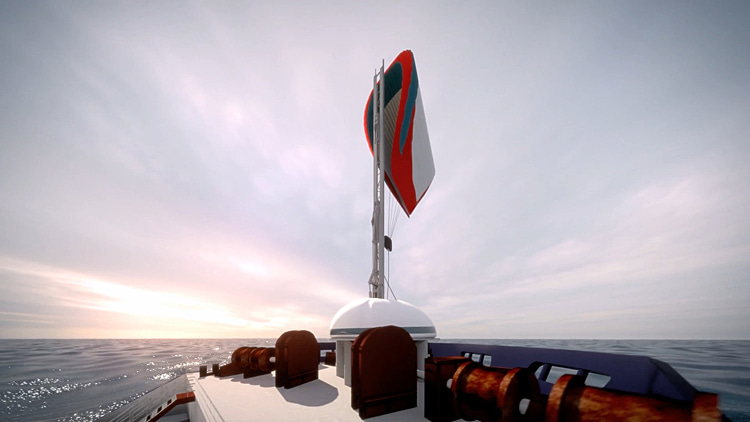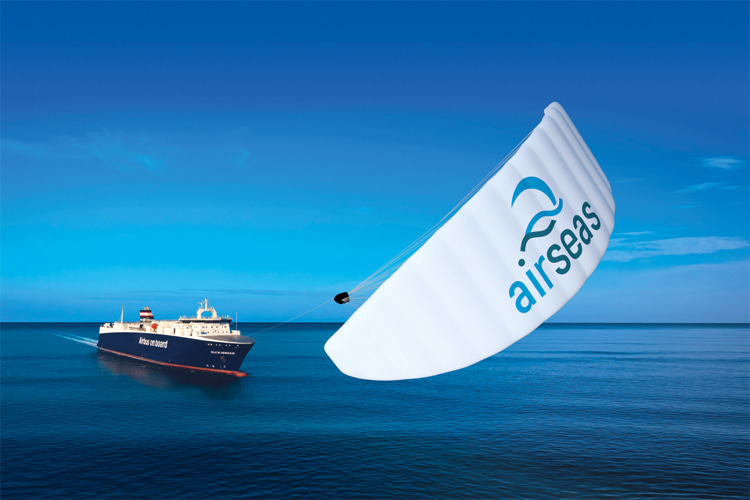AirSeas announced the installation of the first automated kite propulsion system on a commercial vessel.
The cargo ship named "Ville de Bordeaux" was built in 2004, sails under the French flag, and is owned and operated by Louis Dreyfus Armateurs.
The ro-ro ship, the designation given to vessels designed to transport wheeled cargo such as cars, buses, trucks, and railroad vehicles, is expected to deploy the 1,000-square-meter SeaWing kite in January 2022.
AirSeas is a spin-off of the European multinational aerospace company Airbus, founded by Vincent Bernatets and Benoît Gagnaire.
"Ville de Bordeaux" will initiate its monthly transatlantic journey carrying major aircraft components between France and the United States.
The cargo ship will test and conduct sea trials of the wind-assisted technology ahead of its regular operation.
The SeaWing will save tons of bunker fuel and simultaneously reduce emissions from shipping.
The hardware consists of three main components:
The bridge equipment monitors and oversees the operation of the SeaWing.
The deck equipment manages the automated take-off and landing of the sailing wing.
In addition, it features storage space, a mast, trolleys, and winches. After being pulled out, the kite inflates at the top of the mast for take-off.
The flying equipment features the parafoil wing, a flight control pod, and a cable that controls the automated and optimal flight of the kite.
While up in the air, the pod steers the sail to ensure safety and maximize the wind-powered system's efficiency.

Press "On" to Deploy the Kite
But how does the kite-propelled system work on a large and heavy ship? It's relatively simple, thanks to its automated flight control system.
Whenever the ideal wind speed and direction conditions are aligned, the vessel's captain will see the message "SeaWing Launch Recommended" popping up on his control screen.
Then, all he has to do is press "on," and the giant kite will unfold from the bridge window and rise to the sky.
The automated kite powered by AirSeas is based on parafoil technology used to tow commercial ships.
It serves as an auxiliary and backup propulsion system to the traditional ship engines and adds up to 100 tons of traction.
By simply pressing the "on" or "off" switches, the SeaWing will unfold, launch, operate or refold and recover autonomously.
The technology collects and analyzes nearby meteorological and oceanic data in real-time to optimize the ship's energy consumption levels.
The software also allows the captain to plan the route according to the weather variables and advise when to deploy the kite and still reach the destination on schedule.
According to AirSeas, SeaWing will save 20 percent of fuel and reduce gas emissions by 20 percent.
Margins are a critical variable in the shipping business, and fuel costs represent as much as 50 to 60 percent of any ship's total operating costs.
Moreover, to meet The Paris Agreement's goals, the International Maritime Organization (IMO) agreed on cutting CO2 emissions by 40 percent in 2030 to meet The Paris Agreement's goals.
Wind Power: The Future of Shipping
SeaWing's safety standards have been assessed and validated by Airbus.
"Our industrial facility will be able to produce up to 1,000 SeaWing units per year," the company stated.
"The goal is to have 15 percent of the world's fleet equipped with the kite-propulsion system. It's a clean, safe, compact, and reliable that can be installed on any commercial ship."
Recently, AirSeas announced a 20-year agreement deal with Japanese transportation company "K" Line to install SeaWing systems on 50 of its 448 vessels.
SeaWing is a wind-assisted kite propulsion system powered by Airbus that allows cargo ships to save fuel and reduce gas emissions.
To harness the full power of the breeze, SeaWing flies at over 200 meters (656 feet) to capture stronger and steadier winds.
The wing performs dynamically on a figure-of-8 trajectory at over 100 kilometers per hour (62 miles per hour), generating ten times more traction power than a static sail or kite.
